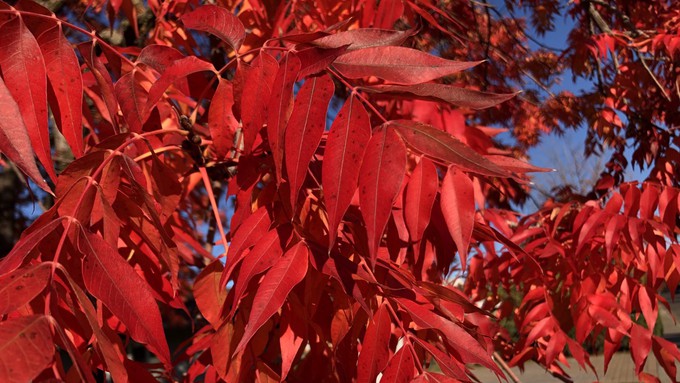
Just in time for fall color, new self-guided tour teaches about varieties on campus

Chinese pistache trees are putting on a show this fall. See many varieties of trees in full color on the walking tour of the UC Davis campus, including the Arboretum and Public Garden. Kathy Morrison
Have you noticed? We’re having a spectacular tree season!
This month, maples, pistaches, ginkgos and other deciduous trees are putting on a colorful show with rich reds, golds and oranges.
Before those leaves are gone, check out the gorgeous trees at the UC Davis Arboretum with the help of a new self-guided tour of campus trees.
“This tour moves you through a 1.5-mile loop on the UC Davis campus while teaching you about both common and unique tree species,” says the arboretum staff. “It’s perfect for navigating in-person from your smartphone!”
You also can check it out on your laptop computer or tablet. Find the links here: https://storymaps.arcgis.com/stories/ed81abebde784d2f824268402fb3ed1b
The tour and virtual resources were created by students participating in the arboretum’s Learning by Leading Tree Stewardship program. Among the thousands of trees on campus, 21 specimens are highlighted on the self-guided tour.
For visitors to the arboretum, parking on campus is free on holidays and weekends.
Besides the tour, the students also came up with several other tree-friendly resources including webpages on the benefits of trees in a suburban environment, the effects of climate change on our trees and forests, and details on a Campus and Community Action Plan with ways students and residents can support their tree canopy.
More details and links: https://arboretum.ucdavis.edu/trees.
-- Debbie Arrington
Comments
0 comments have been posted.Sacramento Digs Gardening to your inbox.
Food in My Back Yard Series
May 6: Maintain soil moisture with mulch for garden success
April 29: What's (already) wrong with my tomato plants?
April 22: Should you stock up on fertilizer? (Yes!)
April 15: Grow culinary herbs in containers
April 8: When to plant summer vegetables
April 1: Don't be fooled by these garden myths
March 25: Fertilizer tips: How to 'feed' your vegetables for healthy growth
March 18: Time to give vegetable seedlings some more space
March 11: Ways to win the fight against weeds
March 4: Potatoes from the garden
Feb. 25: Plant a fruit tree now -- for later
Feb. 18: How to squeeze more food into less space
Feb. 11: When to plant? Consider staggering your transplants
Feb. 4: Starting in seed starting
Sites We Like
Garden Checklist for week of May 4
Enjoy this spring weather – and get gardening!
* Plant, plant, plant! It’s prime planting season in the Sacramento area. Time to set out those tomato transplants along with peppers and eggplants. Pinch off any flowers on new transplants to make them concentrate on establishing roots instead of setting premature fruit.
* Direct-seed melons, cucumbers, summer squash, corn, radishes, pumpkins and annual herbs such as basil.
* Harvest cabbage, lettuce, peas and green onions.
* In the flower garden, direct-seed sunflowers, cosmos, salvia, zinnias, marigolds, celosia and asters. (You also can transplant seedlings for many of the same flowers.)
* Plant dahlia tubers. Other perennials to set out include verbena, coreopsis, coneflower and astilbe.
* Transplant petunias, marigolds and perennial flowers such as astilbe, columbine, coneflowers, coreopsis, dahlias, rudbeckia and verbena.
* Keep an eye out for slugs, snails, earwigs and aphids that want to dine on tender new growth.
* Feed summer bloomers with a balanced fertilizer.
* For continued bloom, cut off spent flowers on roses as well as other flowering plants.
* Add mulch to the garden to maintain moisture. Mulch also cuts down on weeds. But don’t let it mound around the stems or trunks of trees or shrubs. Leave about a 6-inch to 1-foot circle to avoid crown rot or other problems.